Micro - Eukaryotic microbes (Ch.5)
1/12
There's no tags or description
Looks like no tags are added yet.
Name | Mastery | Learn | Test | Matching | Spaced |
|---|
No study sessions yet.
13 Terms
What does the endosymbiotic theory state? --- Know the evidence that supports the endosymbiotic theory
The theory states that the modern day eukaryote evolved from specialized privative prokaryotes. —> these specialized prok where absorbed my larger prok, they could produced their own energy (ATP) (through oxygen) and through photosynthesis - mitochondria and chloroplasts
Proof
mitochondria and chloroplasts are the same size as normal bacteria
mitochondria and chloroplasts and bacteria have own DNA and have similar structure of DNA (circular)
mitochondria and chloroplasts divided similar to how bacteria divide
FUNGI
Why care about them? (What do they do?)
Fungi are eukaryotes
Function: they’re an essential role in decomposing organic matter and returning essential minerals to the soil —> nitrogen cycle
they also potentially used to produced large quantities of antibiotics, alcohol, organic acids, and vitamins
Yeast can be used in beers, wines, and the gas that causes bread to rise
The fungi have their cell walls which give off chemical substances that can cause allergies
Some are can cause diseases: mycoses
Cutaneous- fungal diseases on the skin
Systemic- fungal diseases internal body
Cell morphology differences (difference between mold and yeast – what are dimorphic fungi? What are pseudophyae? What are buds? budding? Bud scars?
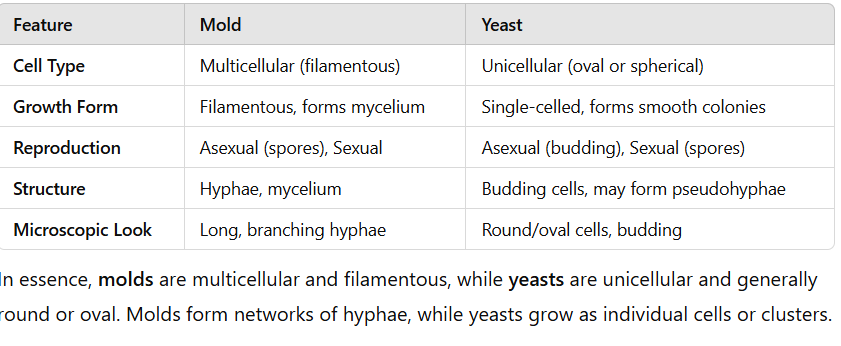
yeast: oval shape, asexual reproduction-grows swellings called buds that become separate cells
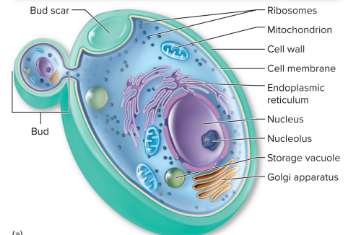
hyphae: long threadlike cells found in bodies of filamentous fungi or molds
pseudohyphae: chain of yeasts formed when buds remain attached in a row → not a true hypha like that of molds
dimorphic: can take either form, depends on growth conditions-some pathogenic
the tendency of some pathogens to alter their growth form from mold to yeast in response to rising temperature.
Buds: in fungi are small growths that form a new individual through asexual reproduction.
Budding in fungi is the process where a new organism grows from a bud and eventually detaches.
Bud scars are the marks left behind on the fungal organism after a bud has formed and separated

Understand basic fungal life cycle – difference between asexual and sexual spores What is the advantage of the sexual spores?
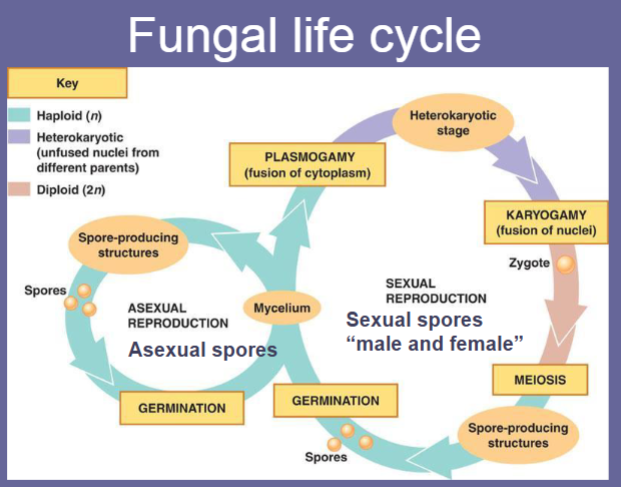
Fungi generally have two phases in their life cycle:
Vegetative phase: This is the growing phase of the fungus, during which the organism is made up of mycelium (the network of hyphal cells).
Reproductive phase: During this phase, fungi produce spores to ensure survival and reproduction.
The life cycle usually alternates between haploid (one set of chromosomes) and diploid (two sets of chromosomes) stages. Spores, which are the reproductive cells, can be produced either asexually or sexually.
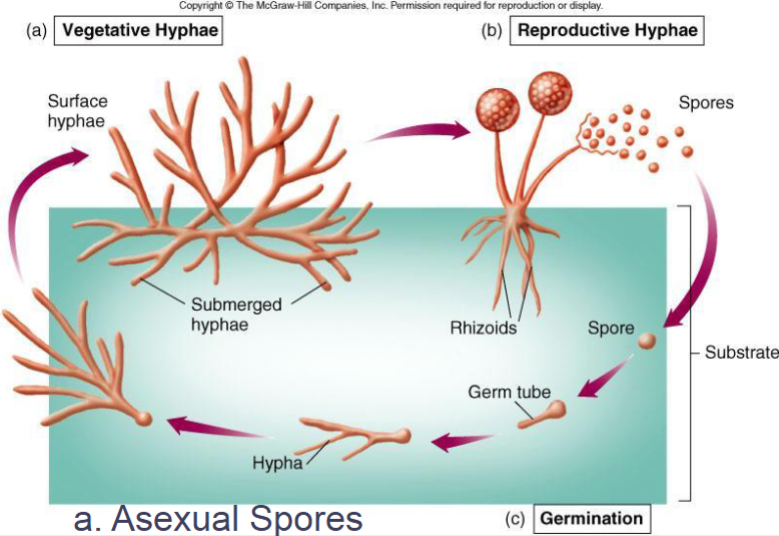
Asexual spores are produced by a single parent fungus without the involvement of another individual.
In asexual reproduction, the spores are produced via mitosis, meaning the spores are genetically identical to the parent fungus. This is typically faster and allows the fungus to rapidly colonize a suitable environment.
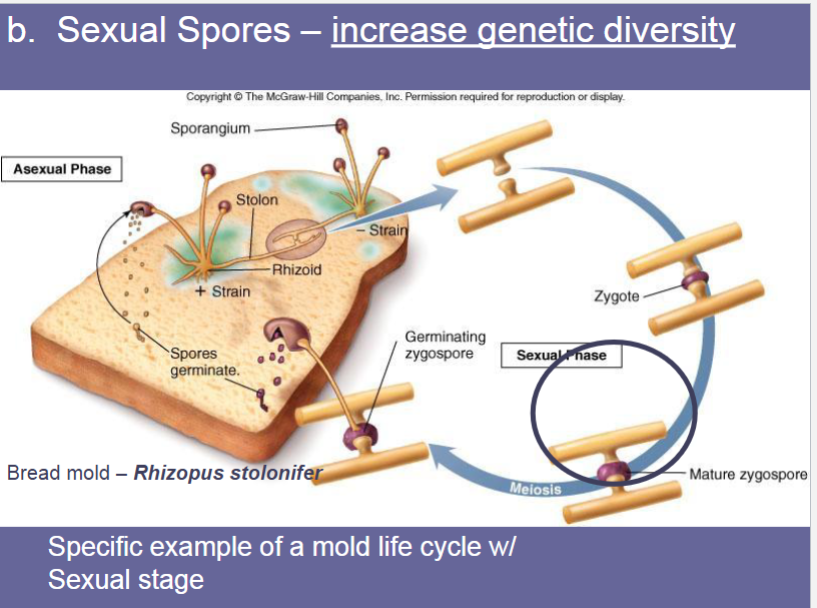
In sexual reproduction, two compatible haploid cells (gametes) from different individuals or different mating types come together to form a diploid zygote.
The diploid zygote undergoes meiosis to produce sexual spores (e.g., ascospores, basidiospores, or zygospores), which are genetically diverse because they contain a mix of genetic material from both parents.
Stages of sexual reproduction:
Plasmogamy: The fusion of cytoplasm from two mating fungal cells (no nuclear fusion yet).
Karyogamy: The fusion of the nuclei from the two cells.
Meiosis: The diploid nucleus undergoes meiosis to produce genetically unique sexual spores.
Germination: These sexual spores germinate when conditions are favorable, forming new fungal individuals.
Genetic Diversity:
Sexual reproduction involves the mixing of genetic material from two different individuals (or different mating types), which results in genetically diverse offspring.
This diversity helps foster adaptation to changing environmental conditions and can improve the chances of survival in fluctuating or stressful environments (e.g., temperature extremes, lack of nutrients, exposure to toxins).
Increased Resistance to Environmental Stress:
Sexual spores, due to their genetic variation, are often more resistant to environmental challenges like disease, desiccation, or the lack of nutrients.
This allows fungi to survive and thrive even when the environment is harsh or when they face new threats, such as pathogens or predators.
Long-Term Survival:
Sexual spores tend to be produced in less favorable conditions (e.g., during periods of stress or resource scarcity). They can often withstand extreme conditions such as drying out or freezing, allowing the fungus to survive harsh periods until the environment improves.
They may also be more likely to survive being dispersed over large distances and colonizing new habitats, improving the fungus's ability to spread.
Evolutionary Advantage:
By promoting genetic recombination, sexual reproduction increases the potential for evolutionary adaptation. Over time, this helps fungi evolve better strategies to compete, survive, and reproduce in their environments.

Structures
hyphae (septate, non-septate)
mycelium
sporangium and sporangiospores
conidia and conidiospores
zygote
hyphae
septate: varies from solid partition with no communication between the compartments to partial walls with small pores that allow the flow of organelles and nutrients between adjacent compartments,
non-septate: consist of one long, continuous cell not divided into individual compartments by cross walls
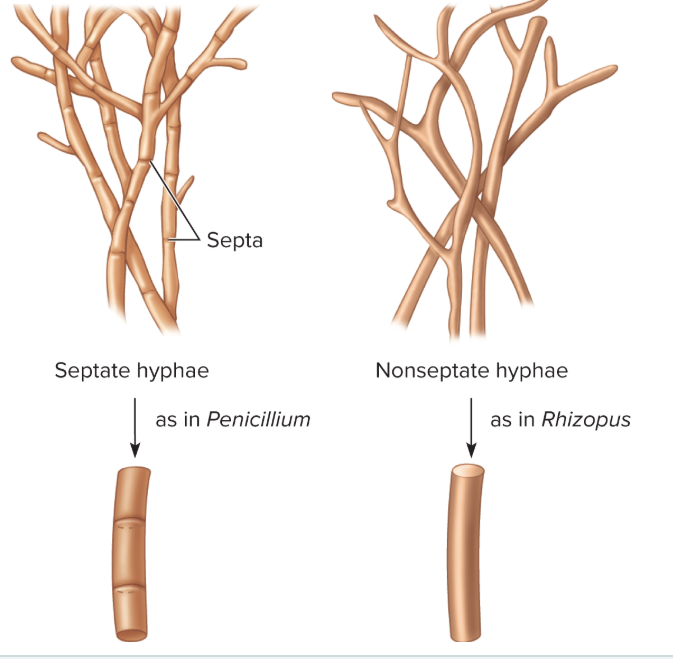
mycelium: The filamentous mass that makes up a mold. Composed of hyphae.
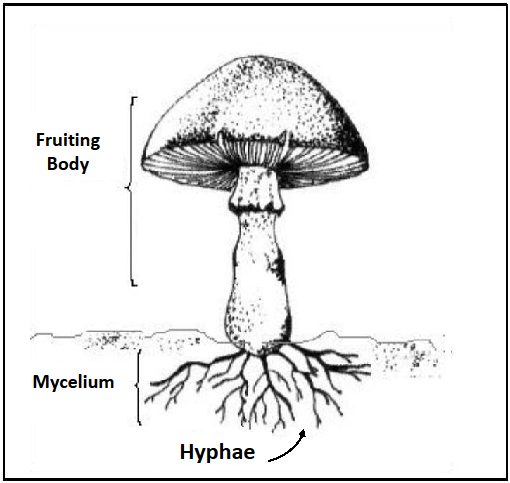
sporangium: A fungal cell in which asexual spores are formed by multiple cell cleavage
sporangiospores: A form of asexual spore in fungi; enclosed in a sac.- SEXUAL SPORES
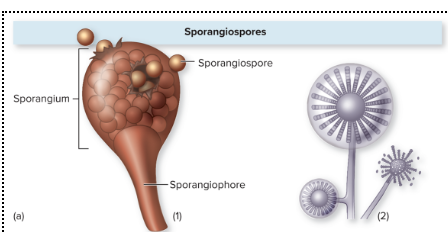
conidia: Asexual fungal spores shed as free units from the tips of fertile hyphae
conidiospores: A type of asexual spore in fungi; not enclosed in a sac. - ASEXUAL SPORES
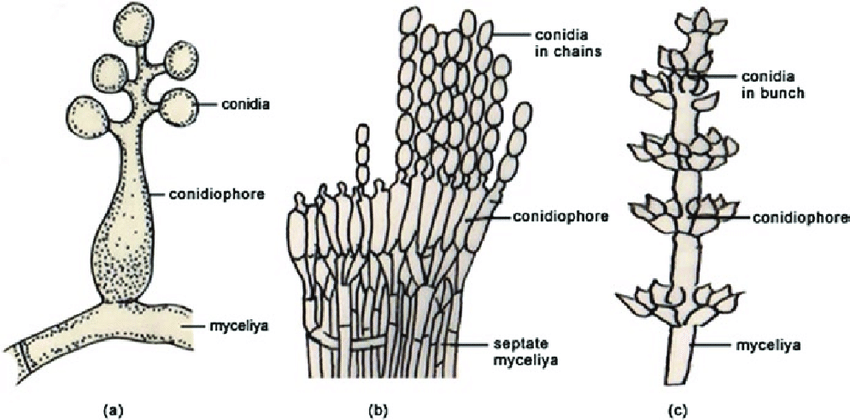
zygote: simple fusion of fertile hyphae of two different strains to a complex union of male and female structures and the development of special fruting structures

PROTOZOANS
Why care about them (What do they do?) How are protozoans classified?
Why care about them
Two classified: Algae and protozoa (eukaryotic unicellular or colonial organism that lack true tissue)
they can cause disease, they also represent the base of the food chain
if removed, it will greatly effect the environment
(What do they do?)
Algae: [single cell, as colonies, in filamentous form- has organelles- chloroplasts] produced 70% of Earth’s oxygen and essential role in the aquatic food web (via plankton)—> they’re nonpathogenic but can produce toxins
protozoa: [single cells containing all major eukaryotic organelles EXCEPT CHLOROPLAST— has specalized organelles that are like mouth digestive system, and “legs” to move]
How are protozoans classified?
based on how they move: → use of flagellated (1-2 long structure) , ciliated (distributed over the entire surface of cell), amoeboid (pseudopods), non-motile, pseudopods
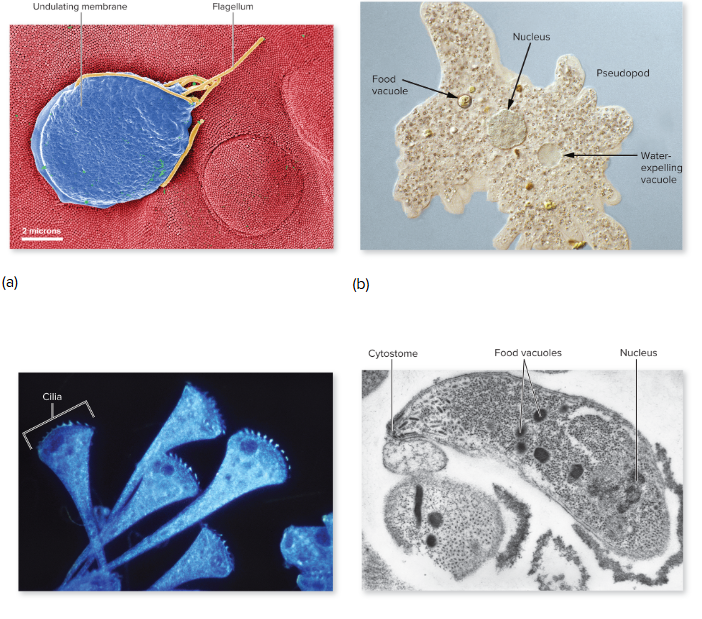
![<p>Why care about them</p><ul><li><p>Two classified: <em>Algae and protozoa (</em>eukaryotic unicellular or colonial organism that lack true tissue)</p></li></ul><ul><li><p>they can cause disease, they also represent the base of the food chain</p></li><li><p>if removed, it will greatly effect the environment</p></li></ul><p>(What do they do?)</p><ul><li><p><em>Algae: [single cell, as colonies, in filamentous form- has organelles- chloroplasts] </em>produced 70% of Earth’s oxygen and essential role in the aquatic food web (via <strong>plankton</strong>)—> they’re nonpathogenic but can <strong>produce toxins </strong></p></li><li><p><em>protozoa: [single cells containing all major eukaryotic organelles EXCEPT CHLOROPLAST— has specalized organelles that are like </em><strong><em>mouth digestive system, and “legs” to move</em></strong><em>]</em></p></li></ul><p>How are protozoans classified?</p><ul><li><p><strong>based on how they move: → </strong>use of flagellated (1-2 long structure) , ciliated (distributed over the entire surface of cell), amoeboid (pseudopods), non-motile, pseudopods</p></li><li><p></p></li></ul><img src="https://knowt-user-attachments.s3.amazonaws.com/57f71e7f-7779-439b-b26f-af78d3d44674.png" data-width="75%" data-align="center" alt="knowt flashcard image"><p></p>](https://knowt-user-attachments.s3.amazonaws.com/57f71e7f-7779-439b-b26f-af78d3d44674.png)
General Life cycle
trophozoite vs. cyst – difference? / do they have a sexual stage to their life cycle? What is the advantage to a sexual stage of the life cycle?
trophozoite: protozoa when they are in their motile feeding stage → requires ample food and moisture to remain active
cyst: The resistant, dormant but infectious form of protozoans. → resting stage→ becomes this when condition in the environment become unfavorable for growth or feeding
Yes, its called conjugation—> advantage is genetic diversity and in evolution
Genetic exchange in which two cells fuse temporarily and exchange micronuclei
In bacteria, the contact between donor and recipient cells associated with the transfer of genetic material such as plasmids. Can involve special (sex) pili. Also a form of sexual recombination in ciliated protozoans.
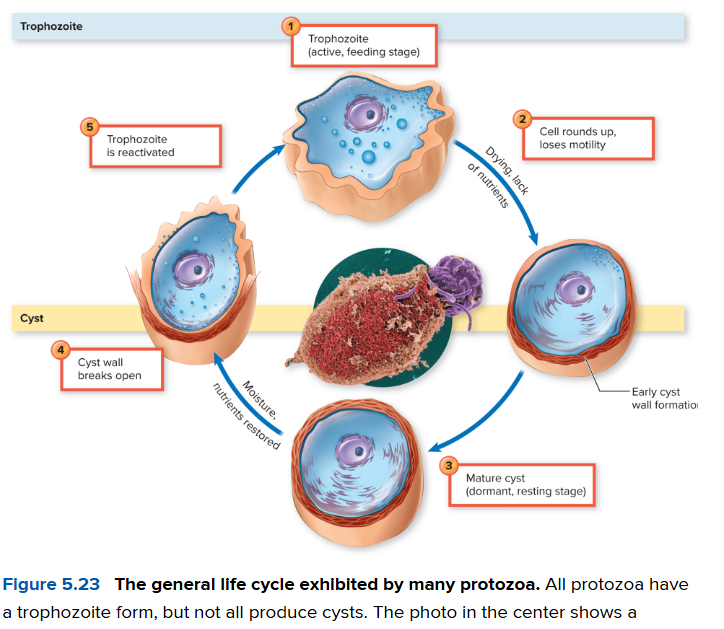
This is the asexual reproduction of a protozoa—> goes through mitosis
go from Trophozoite→ Cyst→ Trophozoite
All depends on its environment and if its favorable for not
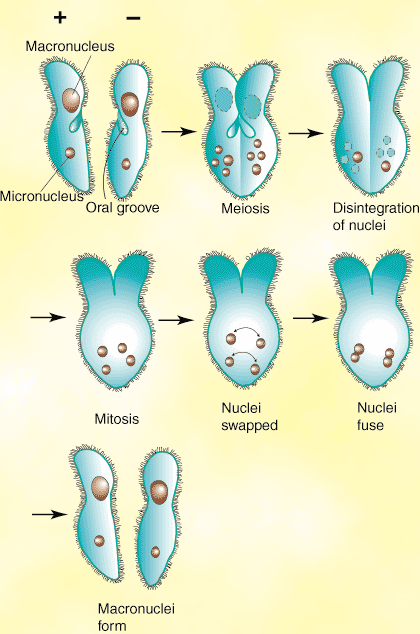

Sexual Reproduction of Protozoa
CONJUGATION-

Know specific info on malaria (Plasmodium) life cycle
1. What is the name of the pathogen that causes malaria? What type of organism is this?
The pathogen that causes malaria is Plasmodium (P. malariae). This type of organism is a protozoan of the sporozoan group, which are also apicomplexans (protozoans that lack organelles for movement)
2. What is the most common and serious complication that can result from a malaria infection?
Some of the common side effects of becoming infected with malaria are: fatigue, aches, nausea, chills, sweating, persistent coughing, weakness, and fever. However, the effect can vary depending on what type of malaria the individual has.
The more serious side of effects are: hemolytic anemia, organ enlargement and rupture (caused by cellular debris that is built up in the spleen, liver, and kidneys), cerebral malaria (where there is an obstruction in the small blood vessels of the brain, caused by an increase in red blood cells sticking to the vessel walls, resulting in decrease of oxygen), coma, and death.
3. Outline the portion of the life cycle of that takes place within humans (may bullet point). Is this the asexual or sexual stage of the life cycle?
It first starts off with the transfer of the sporozoites (a motile, spindle-shaped asexual Plasmodium) from the Anopheles mosquito into the human by biting it. These sporozoites move through the bloodstream into the liver, where they go through the asexual division called schizogony, producing multiple daughter cells, or merozoites. Once the liver cell can no longer contain all the mature merozoites, the cells ruptures and the 2,000-40,000 merozoites enter into the bloodstream which will infect the erythrocytes (i.e. red blood cells) by attaching to special receptors on them. Once a red blood cell is infected, the merozoites become trophozoites (a ring-like structure where the nucleus and cytoplasm are visible) and multiply in order to produce more merozoites. Once the cell can no longer contain the merozoites, the cell ruptures and the merozoites are released to infect other red blood cells, repeating the process. Some of the merozoites are made into specialized gametes, called microgametophytes (male) and microgametocytes (female). These are ingested when another mosquito bites that human. This infects the mosquito, allowing for the spread to continue.
The stage that takes place in humans is the asexual stage.
4. Outline the portion of the life cycle of that takes place within mosquitoes (may bullet point). Is this the asexual or sexual stage of the life cycle?
Once the mosquito has ingested the blood it took from the infected human, the sample will contain the gametocytes, specialized merozoites that are used as gametes for the sexual stage in the mosquito. These gametocytes are microgametophytes (male) and microgametocytes (female). These gametocytes will fuse in the mosquito's digestive tract and form a diploid zygote, called an ookinet. The ookinet then penetrates the mosquito's midgut wall, where it then develops into a oocyst and performs meiosis to form sporozoites. These sporozoites then move to the salivary glands where they will then be injected when the mosquito bites another human for food, continuing the spread of disease.
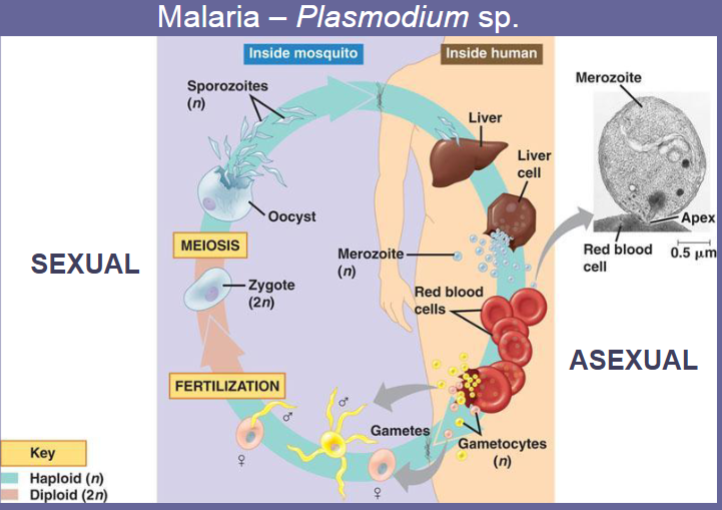
Be able to compare endospores with cyst forms of protozoans and fungal spores
Key Differences:
Endospores are for survival in bacteria and are not involved in reproduction, unlike cysts and spores.
Cysts serve a similar survival function in protozoans, helping them endure harsh environments, but cysts do not participate in reproduction directly.
Fungal spores are primarily reproductive structures, helping fungi spread and reproduce. They may also aid in survival but are typically produced for dispersal and reproduction.
endospores
Structure:
Endospores are tough, multilayered structures that encapsulate the bacterial genome, along with essential cellular components. The outer layers are highly resistant to heat, radiation, chemicals, and desiccation.
They contain dipicolinic acid and calcium ions which contribute to their heat resistance.
Function:
They allow bacteria to survive extreme conditions that would normally kill vegetative cells. When favorable conditions return, endospores can germinate and return to their vegetative (active) state.
Reproduction:
Not a form of reproduction; endospores are a survival mechanism. Only one endospore is produced per bacterial cell.
cyst
Structure:
Cysts are protective, thick-walled structures that encase the protozoan cell. The cell inside the cyst is usually in a dormant or metabolically inactive state, designed to withstand harsh conditions like dehydration, lack of food, or exposure to chemicals.
Protozoan cysts can vary in complexity but typically have a hard outer coating, sometimes with multiple layers.
Function:
The cyst form is a survival mechanism, allowing the protozoan to withstand unfavorable environmental conditions, such as extreme dryness, low nutrients, or changes in temperature.
Cysts help the protozoan survive long periods in a dormant state until conditions improve, at which point the cyst can "excyst" (break open) and the organism becomes active again.
Reproduction:
Cysts are not a method of reproduction but a method of preserving the protozoan during adverse times. Some protozoans may reproduce asexually through binary fission or schizogony while in the active trophozoite state.
fungal spores
Structure:
Asexual spores (e.g., conidia, sporangia) are produced by mitosis, and sexual spores (e.g., ascospores, basidiospores) are produced through meiosis. Fungal spores typically have a single-cell structure in their initial state (except in some multicellular fungi), surrounded by a protective outer coating.
The structure of fungal spores varies depending on the type of fungus. For example, conidia are often smooth-walled while others, like sporangia, are enclosed within a sac-like structure.
Function:
Fungal spores serve as a means of reproduction and dispersion, allowing fungi to colonize new areas and spread to other environments.
Sexual spores introduce genetic diversity, while asexual spores are often produced rapidly to help the fungus proliferate in favorable conditions.
Reproduction:
Fungi reproduce both sexually and asexually through spores. Asexual reproduction produces large numbers of spores that help the fungus rapidly colonize environments. Sexual reproduction produces fewer spores but with greater genetic diversity.
How might you diagnose diseases caused by eukaryotic organisms?
HELMINTH Worms –
Life cycle - know reproductive structures - unusual aspects of life cycle
Helminths form three main life-cycle stages: eggs, larvae and adults. Adult worms infect definitive hosts (those in which sexual development occurs) whereas larval stages may be free-living or parasitize invertebrate vectors, intermediate or paratenic hosts.
Male Hookworm: Has copulatory bursae for attachment to the female, testes for sperm production, and spicules for transferring sperm during mating.
Female Hookworm: Has ovaries for egg production, a uterus where eggs are fertilized and develop, and a vulva for releasing eggs
Complete life cycle consists of adults that preproduce sexually inside host cell (can either be done via two helminths or in one, through the process of Hermaphroditic [Containing the sex organs for both male and female in one individual] then the egg/larva needs to be transported to new host
Diseases they cause and how they might be diagnosed in an infected individual
Diagnosis is made by examining samples of stool, blood, or other tissues for the presence of worms or their eggs


Know the life cycle of Hookworm
Pernitrates through unbroken skin, attaches to small intestinal wall sucking host’s blood
Eggs are shed through human feces (diagnosis stage - see under microscope)
If eggs make it to soil will hatch into larvae (immature: rhabditiform→ mature: filariform [can survive in soil for 3-4 week])
filariform larvae burrow through the host unbroken skin (usually foot- most contact with the soil)
Enters bloodstream→ heart→ lungs (gets coughed up)→ pharynx (swallowed)→ stomach (survives stomach acid)→ small intestine. Where they mature into adults worms
Attach to small intestinal wall sucking host’s blood for years
adults worms then reproduce sexually inside host (can either be done via two helminths or in one, through the process of Hermaphroditic [Containing the sex organs for both male and female in one individual]
Eggs are then releases via feces and then the cycle begins again
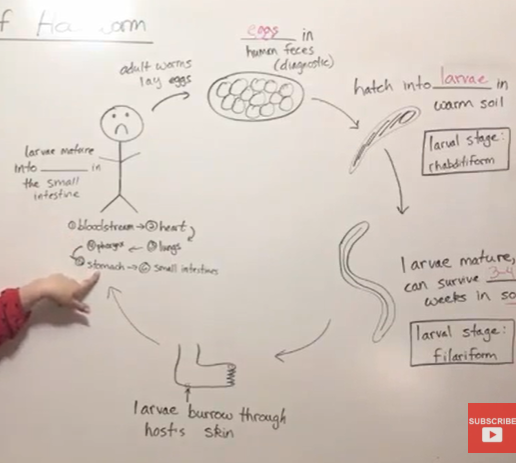
![<p>Pernitrates through unbroken skin, attaches to small intestinal wall sucking host’s blood</p><ol><li><p><strong>Eggs </strong>are shed through human feces (diagnosis stage - see under microscope)</p></li><li><p>If eggs make it to soil will hatch into <strong>larvae </strong>(immature: rhabditiform→ mature: filariform [can survive in soil for 3-4 week])</p></li><li><p>filariform larvae <strong>burrow through the host unbroken skin </strong>(usually foot- most contact with the soil)</p></li><li><p><strong>Enters bloodstream→ heart→ lungs (gets coughed up)→ pharynx (swallowed)→ stomach (survives stomach acid)→ small intestine. Where they mature into adults worms</strong></p></li><li><p>Attach to small intestinal wall sucking host’s blood for years</p></li><li><p>adults worms then reproduce sexually inside host (can either be done via two helminths or in one, through the process of <strong>Hermaphroditic </strong>[Containing the sex organs for both male and female in one individual]</p></li><li><p>Eggs are then releases via feces and then the cycle begins again</p></li><li><p></p></li></ol><img src="https://knowt-user-attachments.s3.amazonaws.com/d5dd251d-bc18-491a-a97d-1b15f206ce19.png" data-width="100%" data-align="center" alt="knowt flashcard image"><p></p>](https://knowt-user-attachments.s3.amazonaws.com/d5dd251d-bc18-491a-a97d-1b15f206ce19.png)